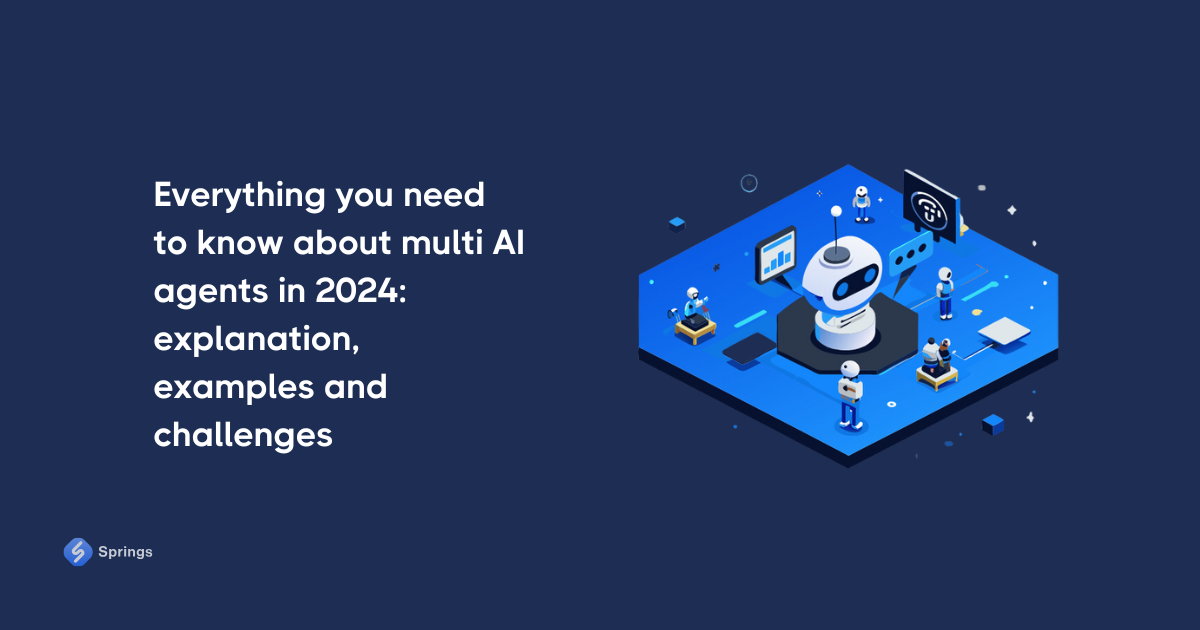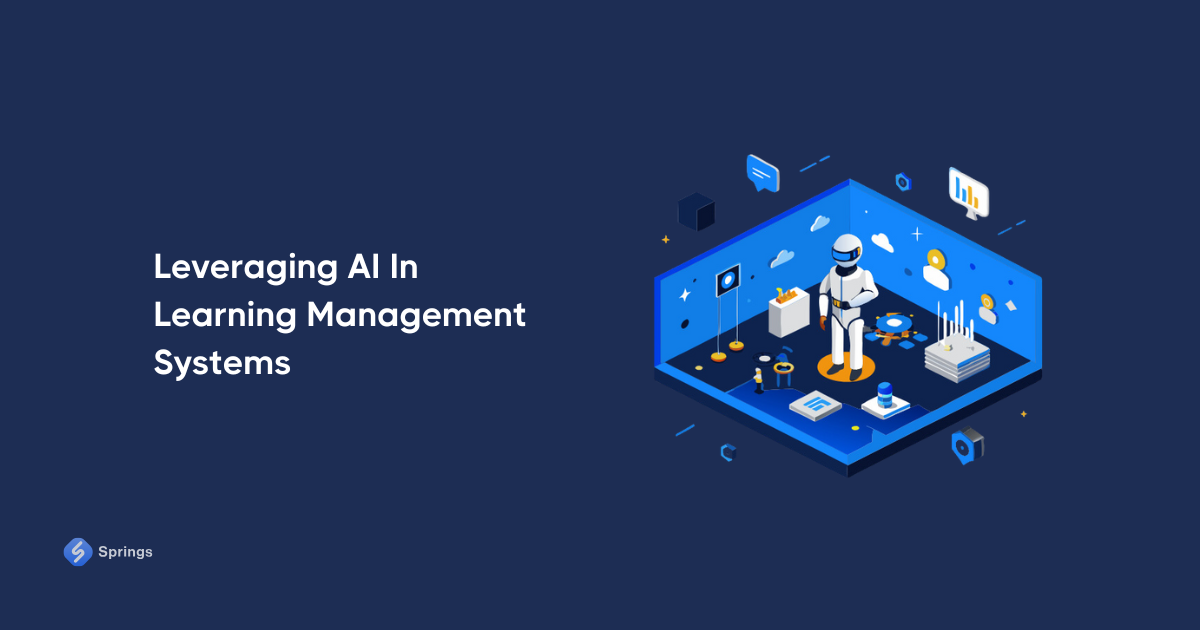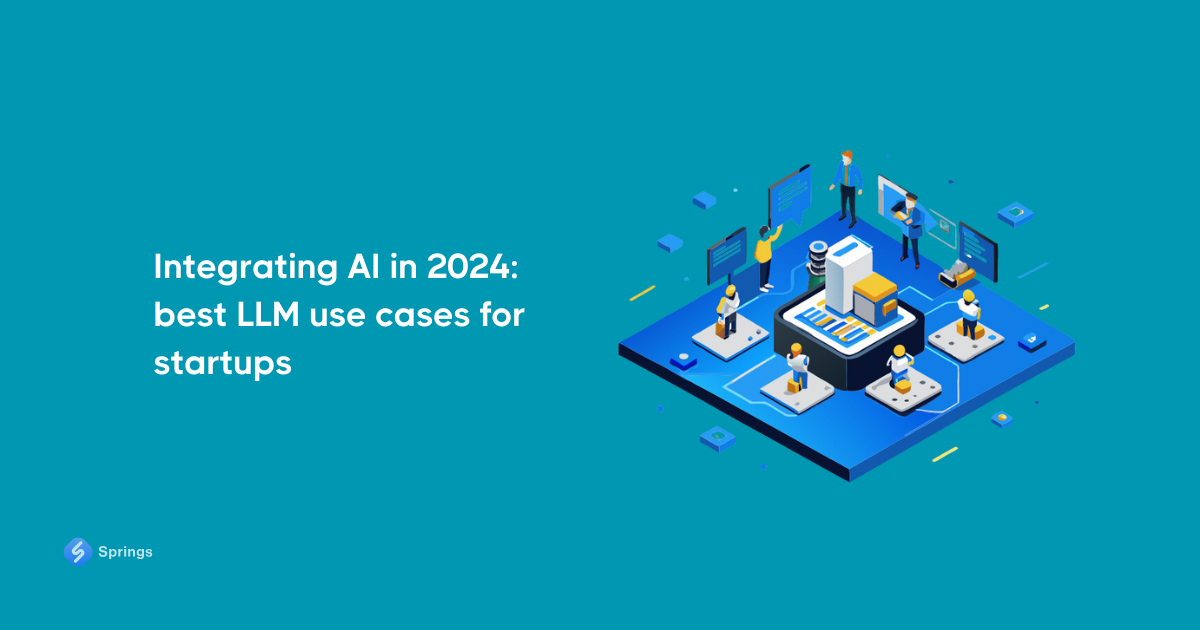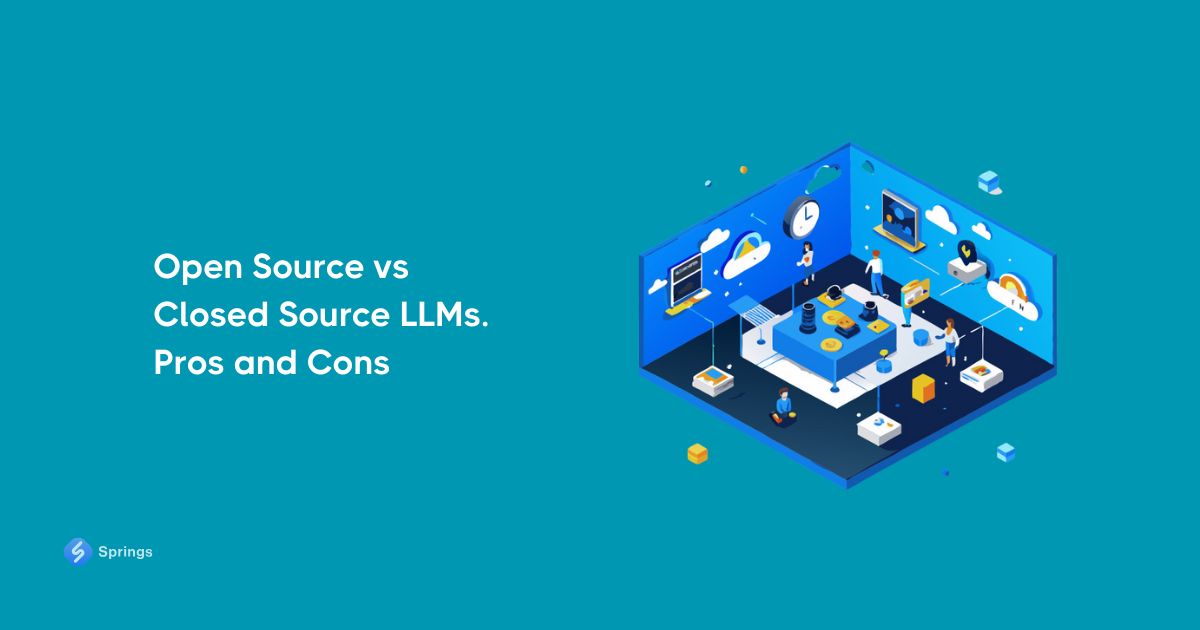Agents in Artificial Intelligence: What Are They And How They Are Used
Overview
“The Matrix” movie is the first thing a lot of people think about when they hear the word “agent”. Yeah, we all remember this iconic character - Agent Smith- who acted throughout the whole trilogy. It is worth remembering that Agent Smith is a program, a simulated reality created by machines to subdue the human population while their bodies are used as an energy source. Initially an "Agent" of the system, he eliminates threats to the Matrix and maintains order.
Of course, we won’t be talking about that film but it is a mind-blowing point that this word became popular again after 25 years passed over the first movie.
Today, we hear the word “agent” more and more frequently, especially in the fields of AI development, machine learning, and different large language model integrations.
According to the Markets and Markets research, the global Autonomous AI and Autonomous Agents Market is estimated to be worth almost $29 billion by 2028 at a CAGR of 43% during the forecast period. In other words, the market will increase almost six times compared to 2024. These numbers are incredible compared to the regular business stats we may see in other industries where the annual growth usually could be higher.
Agents are becoming a must-have software for many businesses, and I am sure this is only the beginning of the era of AI agent platforms. Such platforms allow businesses to integrate and customize agents according to their specific needs, and do not waste a lot of time on self-learning.
Artificial intelligence and intelligent agents stand on the same stage today, so in this article, we will try to discover the agent's core features in artificial intelligence, its main characteristics, and workflow. We will focus on the technical aspects of their capabilities, look “under the hood”, and research the types of agents.
Let’s go!
What are Agents in Artificial Intelligence?
So, let’s start with the basics, and try to find out - what is an intelligent agent in AI, how it differs from a chatbot, and other software AI types.
If we ask ChatGPT, this model will answer that an agent in artificial intelligence is an autonomous entity that perceives its environment through sensors and acts upon that environment through actuators to achieve specific goals.
In other words, we may define an AI agent as intelligent software that is developed to perform specific tasks or achieve predefined goals on behalf of users or companies. Key features of intelligent agent in AI include the following:
- Autonomy. Agent in artificial intelligence operates always without human intervention, making decisions learning from its own experience, and improving performance over time.
- Perception. AI agents use triggers to gather data from their environment. In the case of software agents, this might involve receiving input from a user interface or data streams.
- Reasoning. All artificial intelligence and intelligent agents have the ability to process information and make decisions. This involves using the latest AI technologies, machine learning models, or other forms of artificial intelligence to interpret data and determine the best course of action.
- Action. Agents in AI can take actions to influence its environment. This might involve sending commands to a system, generating responses to user queries, or making recommendations.
- Specific Behavior. Agents in AI are created to achieve specific objectives, which can be predefined or dynamically determined based on different contexts.
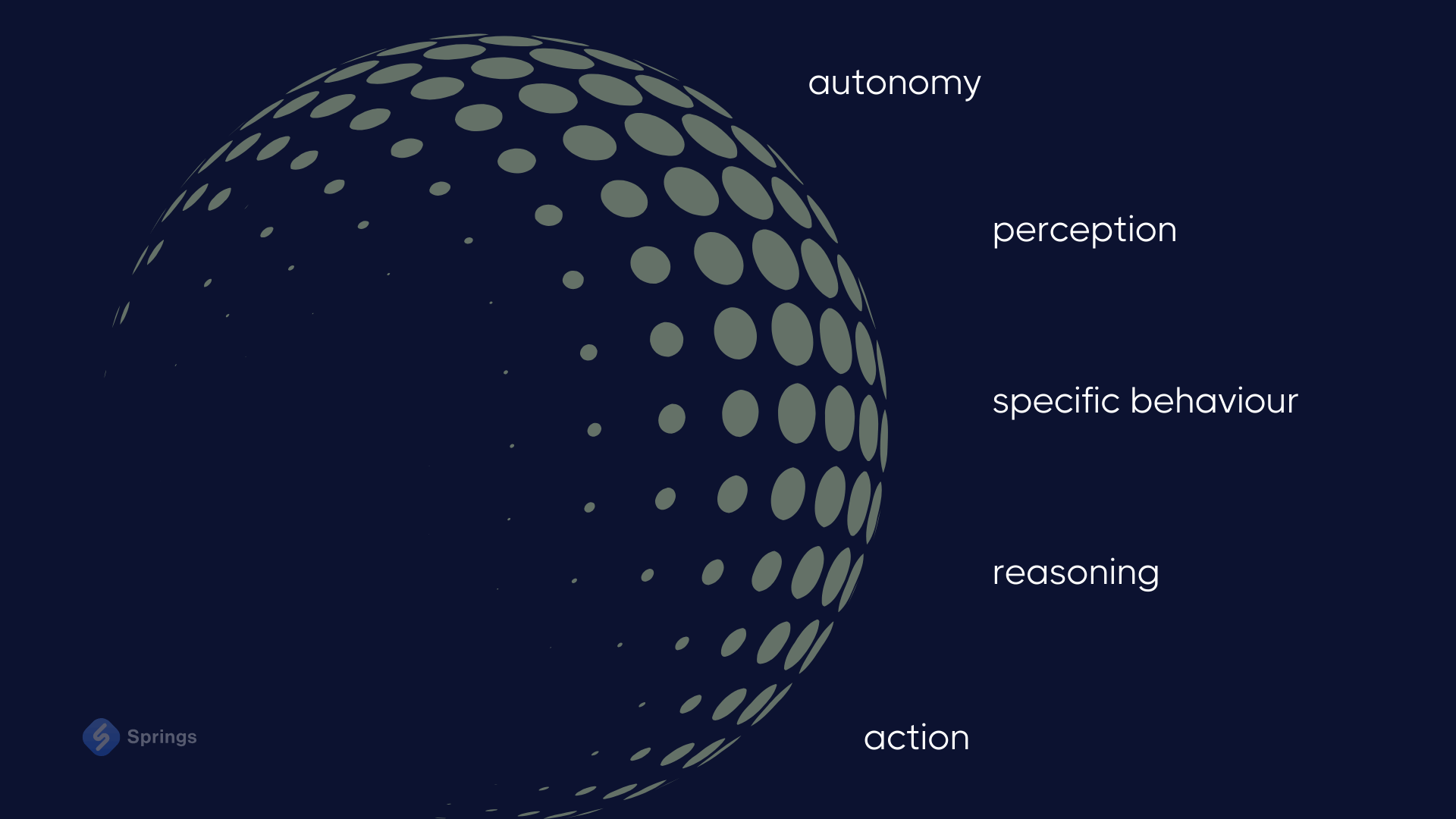
Examples of intelligent agents in AI include NLP-based chatbots that interact with users, recommendation systems that suggest products or content, and many other autonomous software solutions that perform driving decisions.
One of the most common questions for many business owners is the difference between an AI chatbot and an AI agent. Let’s try to answer this question.
What is the Difference Between Agent and Chatbot?
To keep it simple, we may say that an agent and a chatbot differ primarily in their scope, capabilities, and application contexts. AI agent, in a broad sense, refers to any independent entity capable of observing and acting upon its environment to achieve specific goals. Most of the agents possess advanced capabilities, including complex decision-making, interaction with various systems, and the use of advanced AI tech stacks such as reinforcement learning or computer vision.
On the other hand, a chatbot is a specialized type of agent usually developed for conversational interactions through text, video, or voice. E.g., AI chatbots focus on understanding and responding to user inputs within the context of a conversation. They are often used in customer support, virtual assistance, and user engagement on different web and mobile platforms. In contrast to the diverse applications of agents, chatbots are usually customized for interactive communication and are limited to predefined conversational contexts.
Let’s have a look at the comparison table below to understand this difference.
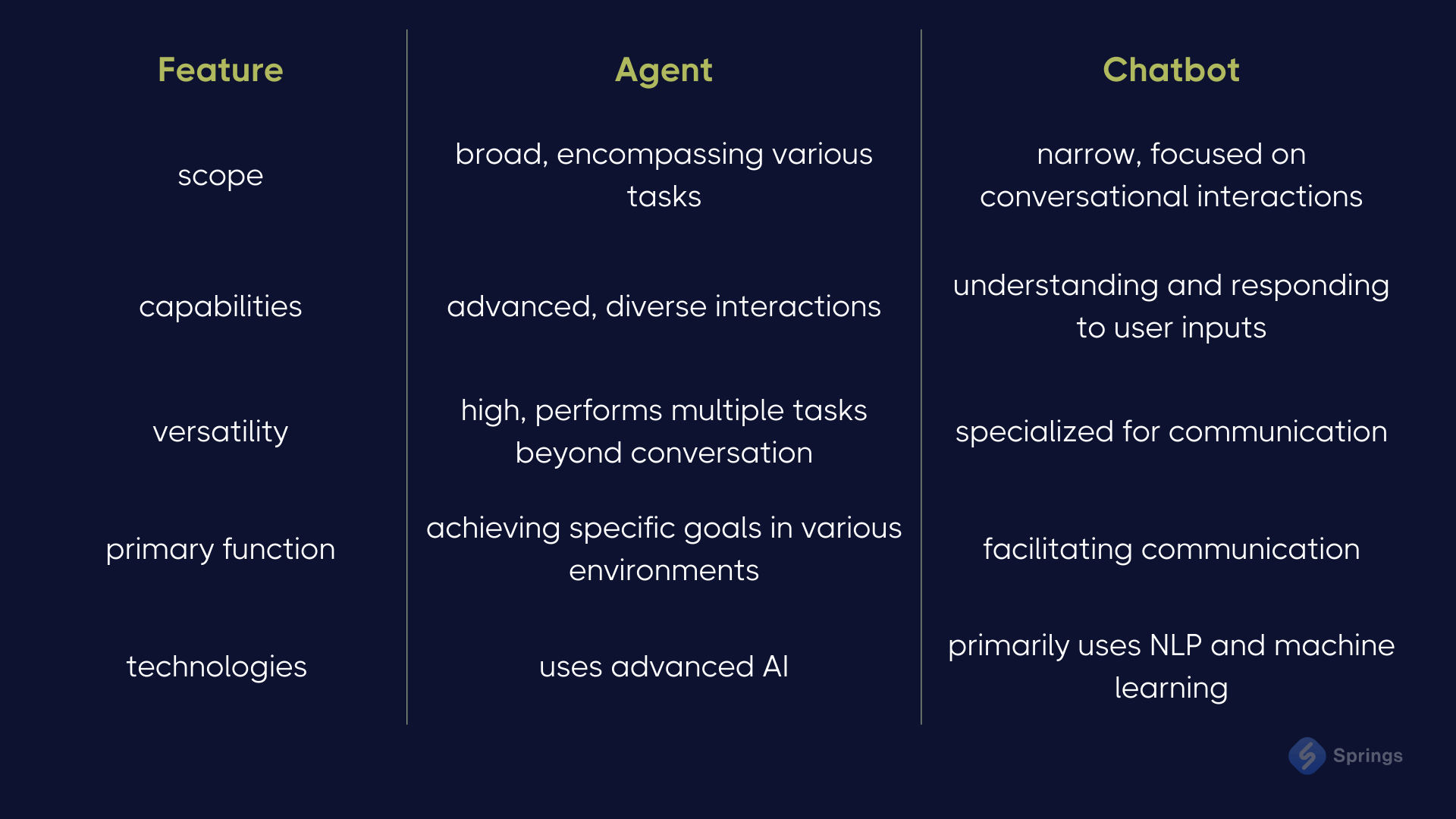
Overall, agent in artificial intelligence represent a broader category with more diverse applications and capabilities beyond conversational interactions, while chatbots can be considered agents due to their autonomous operation and interaction with users, not all agents are chatbots.
What is the Multi-Agent System (MAS)?
A Multi-Agent System (MAS) is a collection of agents that include both artificial intelligence and human agents. These agents interact with each other and the environment to achieve specific objectives, like solving customer care problems or smart searching for specific information. In MAS, it is generally assumed that agents possess incomplete knowledge about the environment and the internal states of other agents.
Core Features of MAS:
- Autonomy. Each agent operates independently, making decisions without direct intervention.
- Social Ability. Agents interact with other agents through communication, enabling collaboration and information sharing.
- Reactivity and Proactivity. Agents perceive their environment and respond to changes (reactivity) while also taking the initiative to achieve their goals (proactivity).
Using MAS offers advantages over single-agent systems in various contexts. For example, the usage of a swarm of simpler robots instead of a single complex agent can reduce design complexity, enhance economic efficiency, and improve scalability. Additionally, the overall system reliability increases, as the failure of a few robots does not significantly impact the collective goal achievement.
Agents in artificial intelligence are inclined to collaborate when they recognize the mutual benefits and understand the necessity of cooperation to attain their goals. They cooperate with other agents with complementary capabilities, forming teams to address multiple challenges. Within these teams, artificial intelligence and intelligent agents engage in negotiation and coordination to devise and execute action plans for problem-solving.
Components of an AI Agent
AI agents consist of various components that form their structure or software, each with distinct capabilities. There are components that are usually defined as the basis for the regular AI agent:
- Actuator
- Percept (sensor)
- Knowledge Base
- Processor
Let’s look at them in depth.
Actuator
An actuator is a component responsible for converting the agent's decisions into physical actions or changes in the environment. Actuators enable the agent to interact with and manipulate its surroundings, executing the actions determined by the agent's internal decision-making processes.
Examples of actuators include:
- Voice Synthesizers. These systems generate spoken responses, enabling AI agents like virtual assistants to interact with users through speech.
- Text Generators. These components are responsible for generating and dispatching text-based responses to users. They transform the chatbot's processed replies into deliverable messages via a chat interface.
- API Integrations. This actuator allows the AI agent to interact with external systems, such as a company's CRM, like Hubspot, to access customer data, create support tickets, or check order statuses. This integration enables the AI agent to retrieve or update information seamlessly.
- Notification Systems. These actuators send notifications, such as email or SMS messages, to keep users engaged and informed. They can deliver push notifications about upcoming appointments, order status changes, promotions, or other relevant updates, ensuring timely communication with users.
Percept (Sensor)
Percept or sensor, is the sensory input that an AI agent gathers from its environment, offering insights into the current state of observable conditions. For instance, if we are talking about the customer service agent, percept can encompass:
- Incoming messages
- User profile details
- Geolocation data
- Chat history
- Language preferences
- Time and date information
- User preferences
- Emotional state detection
Generally, percepts let the agent sense its surroundings to gather inputs from the world: images, sounds, radio frequencies, etc. These sensors can be cameras, microphones, or antennae, among other things. For software AI agents, it could be a web search function or a tool to read PDF files.
Knowledge Base
The knowledge base (KB) is a repository where the AI agent stores its initial understanding of the environment, either pre-defined or acquired through the model training. This core knowledge is crucial for the agent's decision-making process, and performing needed analysis.
For example, a self-driving car's knowledge base might include traffic laws and local regulations, while an autonomous customer service agent would have access to product information and return policies.
Businesses that use AI agents must train them with company-related data, and fill KB with the latest information. Although both open-source and closed-source LLMs can draw from broader internet sources, an AI agent with a specialized function requires tailored information to deliver user-specific outputs.
Processor
The processor (task creator, proxy agent) is the core of almost any agent. It operates like a Central Processing Unit (CPU), determining and sequencing essential tasks. It is pivotal in managing the Large Language Models, integrating it with long-term memory, and coordinating with external tools as necessary.
The processor handles information from the percepts (sensors), evaluates the optimal course of action, and issues commands to the actuators.
For a better understanding of how processor combines with actuators and percepts, let’s have a look at the agent workflow:
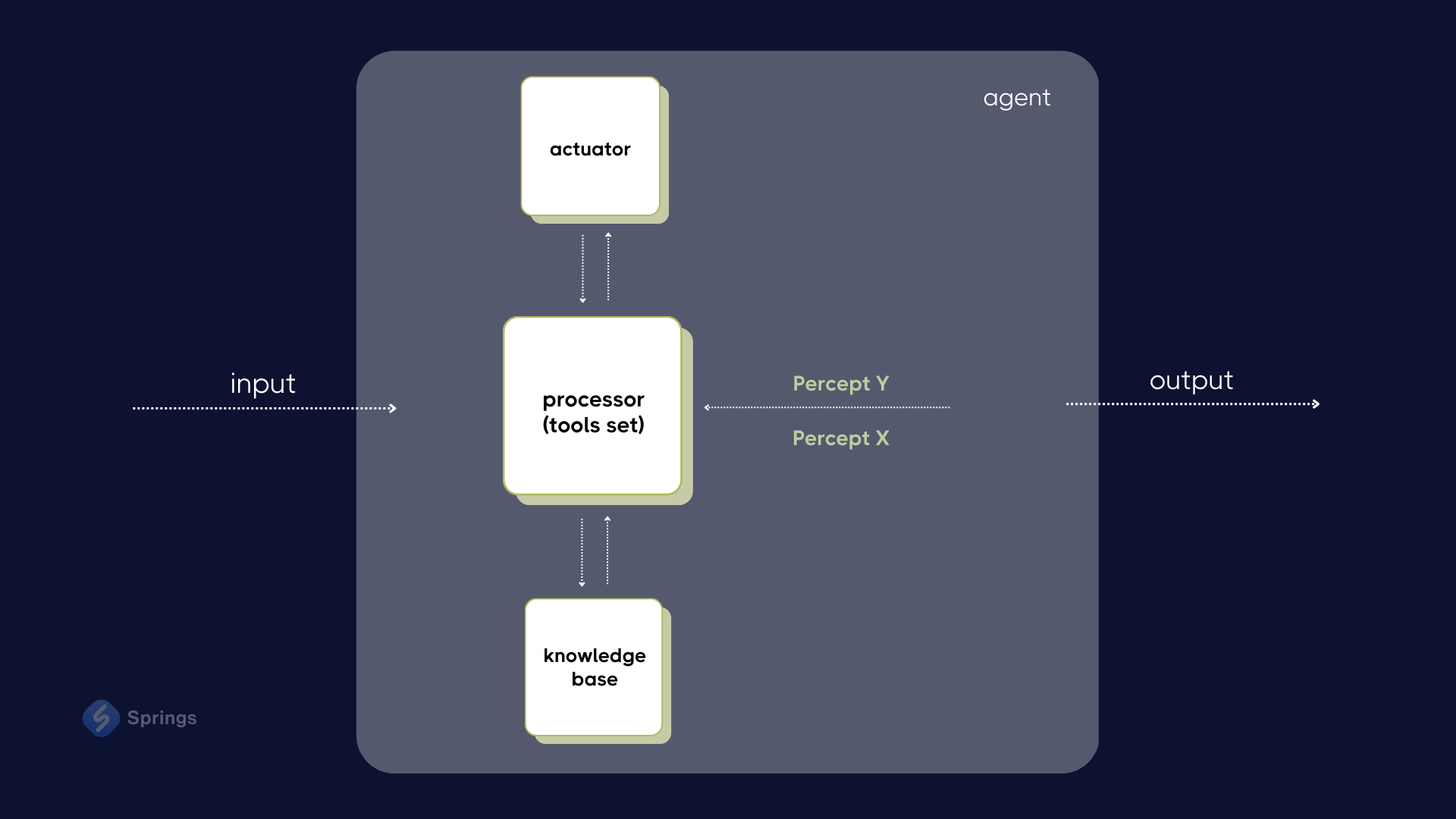
The structure of an AI agent varies significantly based on its tasks, meaning some AI agents may include all components while others do not. For instance, a smart home system might only have basic sensors, actuators, and a simple processor.
At the same time, a self-driving car incorporates all elements: it requires percepts to detect the road, actuators to control movement, a processor for lane changes, and a KB to store needed data.
How Does Intelligent Agents Work?
Previously, we discovered the core components of an AI Agent. Now, it is time to understand how they work “under the hood”.
AI Agent Modules
There are four modules in the structure of an intelligent agent in AI that help it process all the needed tasks:
- Profiling Module. Determines the agent's function or role, defining its purpose and scope of operation.
- Memory Module. Enables the agent to recall past behaviors, experiences, and outcomes, crucial for learning and adaptation.
- Planning Modules. Allow the agent to strategize and plan future actions based on its goals and gathered information.
- Action Module. Translates the agent's decisions into specific actions, executing planned tasks to achieve desired outcomes.
Profiling Module
AI agents perform tasks while embodying specific roles, such as constructors, developers, educators, or domain experts. The profiling module identifies these roles, typically embedded in input prompts to influence the behavior of LLM integrations. Three common approaches to creating agent profiles are:
- Handcrafting Method. Manually specifies agent profiles with characteristics like personality and relationships, though labor-intensive for numerous agents.
- LLM-Generation Method. Automates profile creation through LLM generation using manually crafted seed profiles and prompt engineering.
- Dataset Alignment Method. Defines profiles based on real-world datasets, using demographic details to align virtual agents with real population attributes.
Data utilized for profiling may include demographic information and psychological traits, among other aspects.
Memory Module
The memory module functions as the AI's memory database, storing information from the environment to inform future actions. It enables the agent to accumulate experiences, enhancing its ability to make consistent, reasonable, and effective decisions.
There are basic memory formats that include:
- Natural Languages. Allow flexible and rich storage.
- Embeddings. Represent retrieval efficiency.
- Databases. Provide structured storage.
- Structured Lists. Deliver concise information.
Planning Module
The planning module endows agents with the capability to strategize for complex tasks, enhancing their comprehensiveness, potency, and reliability. AI agent planning is divided into two major categories:
- Without Feedback. Agents devise plans without incorporating feedback using strategies like subgoal decomposition, multi-way thought, and external planners.
- With Feedback. This type of panning incorporates environmental, human, or model feedback, providing planning proficiency through iterative feedback loops.
Action Module
The main purpose of the action module is to transform the agent's decisions into specific outcomes, facilitating direct interaction with the environment and determining task completion. All the actions in this module can be divided into three main sub-domains:
- Target. Goals may include task completion, dialogue interaction, or environment exploration.
- Strategy. Strategies include memory recollection, multi-round interaction, feedback adjustment, and incorporating external tools.
- Space. Spaces define possible actions from external tools (e.g., APIs) and the agent's knowledge, expanding action potential.
Finally, the agent’s architecture is compiled by essential modules that collectively enable autonomous, intelligent behavior, each contributing uniquely to the agent's overall performance. Understanding and optimizing these components is important for developing AI solutions at the highest level.
AI Agent Workflow
As with any other tool, an agent in artificial intelligence has its own workflow. Let’s look at its steps deeply.
Step 1. Planning
As a user, you define your goal for the AI agent. The AI algorithm then formulates a detailed plan to achieve this goal. For instance, if your goal is to "Find the Best Autonomous Agent Project," the application will:
Define what "the best" means and create a checklist.
Search for the best autonomous agent projects based on that checklist.
Step 2. Tool Selection
The AI agent evaluates available resources and selects the most suitable set of tools for executing the plan. For studying autonomous agents, the AI might choose:
ChatGPT-4o to establish criteria for the "best" framework.
A search engine like Google for comprehensive online research.
Step 3. Execution
The next step for the agent is to activate the selected tools to perform the tasks. For example:
ChatGPT might determine that "the best" means the most popular, leading to the GitHub repository with the most likes.
It then searches for the "Most liked Autonomous Agent GitHub repository" on Google.
Step 4. Evaluation
The last step for AI agents will be reviewing the results, and comparing them against the original goals and plans. If the results align with the goals, the process concludes. If not, the app will identify which steps need to be repeated. For example, if it finds multiple AI agent projects with similar likes on GitHub, it may need to redefine its criteria and revisit the tool selection phase.
Let’s have a look at the schema below to see how it works:
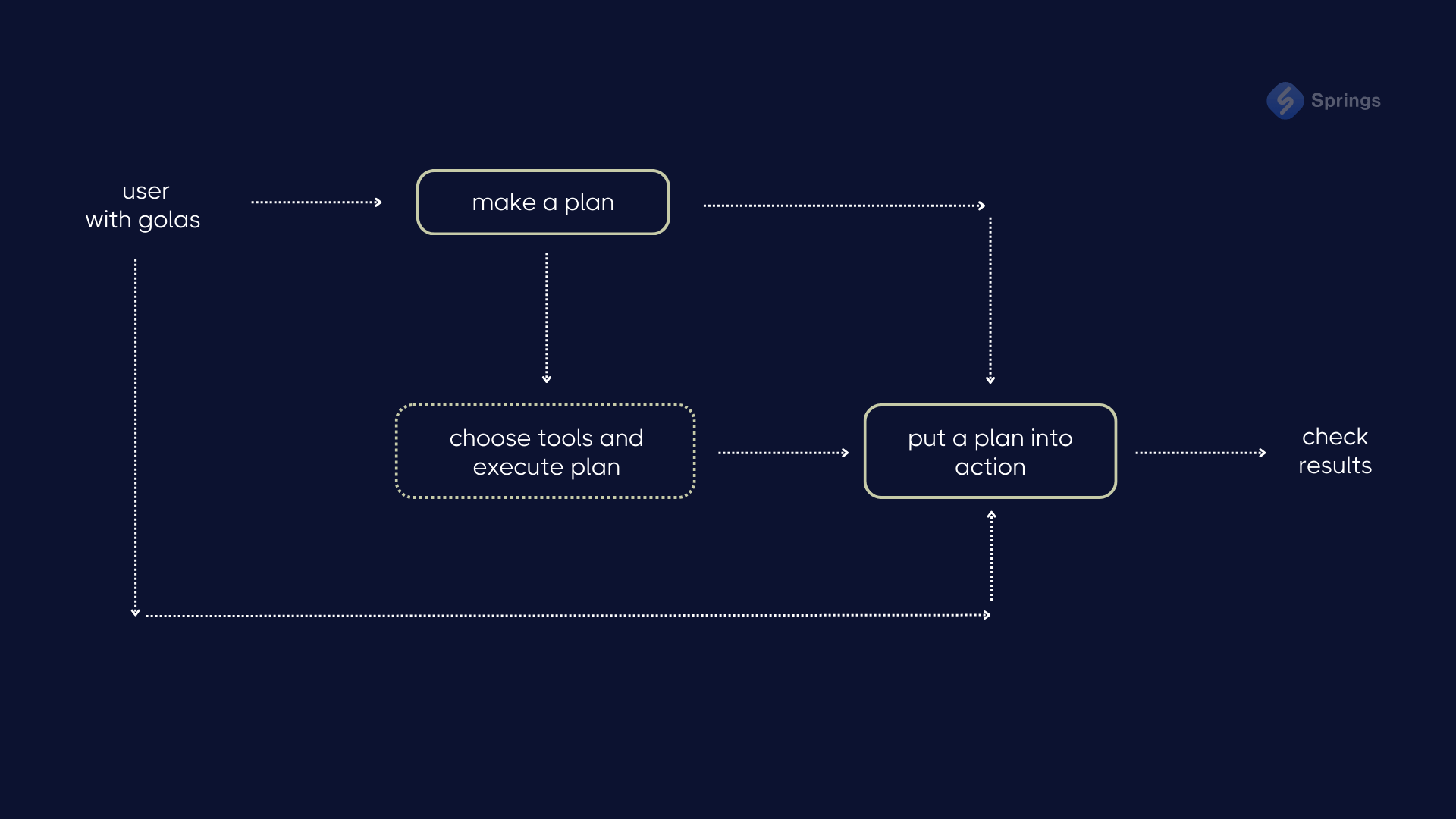
This iterative process ensures the AI agent effectively meets the user's objectives.
Types of AI Agents
There are different types of agent in AI according to their structure, components, and possibilities to apply in multiple areas. Let’s look at them in depth.
- Simple-Reflex Agents. These agents respond to a stimulus detected by one or a few sensors. Once the signal is detected, they interpret it, make a decision, and produce an action or output. These AI types of agents can be found in smart home systems or thermostats.
- Model-based Reflex Agents. This type of AI agent maintains an active internal state, gathering information about how the world works and how its actions affect it. This helps improve decision-making over time. Examples of this category may include predictive analytics in warehouses and self-driving cars.
- Goal-Based Agents. AI agents are capable of creating strategies to solve specific problems. They generate task lists, take steps to solve these tasks, and assess whether their actions are moving them closer to their goals. These types of agents in AI can be seen in applications ranging from defeating human chess masters to AI apps.
- Utility-Based Agents. The power of AI agents is to evaluate the outcomes of decisions in scenarios with many viable courses of action. They can easily run each possibility and score it based on a utility function, which could prioritize the cheapest, fastest, or most efficient option. These AI types of agents are able even to optimize city traffic and recommend different TV shows.
- Learning Agents. Education and Learning are widely used areas for AI agents. Learning agents adapt to their surroundings and use a problem generator to create tests to explore the environment. These types of agents in AI are instrumental in preventing spam from landing in your inbox.
Is worth saying that there could be other options to define the types of agent in AI. It all depends on how you want to classify them, and what criteria to choose. Anyway, the AI agent classification helps us to better understand the diverse applications and functionalities AI brings to various fields, from smart home devices to custom industrial web and mobile solutions.
AI Agents Use Cases
When can be AI Agents applied? How they can be applied in terms of your business? Let’s try to find it out.
AI agents can manage tasks, dependencies, deadlines, obstacles, and solutions, reducing the need for constant communication and operational costs. By integrating seamlessly into your existing workflows, AI agents can enhance information flow between departments and update project milestones based on real-time data. And this is not the end of their usage. Here are several use cases when agents can be applied.
AI Agents in Marketing
AI agents are revolutionizing marketing by automating tasks and providing valuable insights. The common ways they may be used are as follows:
- Advertisement. AI agents handle ad creation, performance monitoring, and optimization of ads, allowing marketers to focus on strategy and more complex tasks.
- Content Creation and SMM. Agents are fully capable of ensuring consistent brand voice across web and mobile platforms, and social media. They may also produce content that completely resonates with audiences.
- Market Analysis. AI agents can analyze social media and reviews to gauge public sentiment, making strategic adjustments based on trends and preferences.
AI Agents in Sales
Sales-oriented AI agents, especially AI chatbots, go beyond addressing customer inquiries by proactively guiding conversations toward securing sales. They can be used in the following ways:
- Lead Generation. AI agents can identify and engage prospects, and ICPs, reducing the time and effort required for manual lead identification.
- Sales Strategy. AI agents can provide specific information and maintain positive customer relationships, driving towards successful sales.
- Sales Funnel Processing. By integrating with CRMs or other tools used by a sales team, AI agents can process the sales funnel automatically. In this way, the sales team will benefit by focusing on the more important tasks.
AI Agents in Education
AI agents are capable of transforming education by enhancing personalized learning, automating multiple tasks, and providing innovative educational tools, such as AI-powered LMSs, and similar. Here are the most common use cases in this area:
- Personalized Learning. AI agents analyze student performance and learning styles to create customized learning plans. By adapting to students’ needs, they can provide targeted resources, exercises, and feedback, ensuring a more effective and engaging learning experience.
- Intelligent Tutoring. Modern AI tutor software offers real-time assistance, answers questions, and explains concepts. These AI avatars can identify areas where students struggle and provide additional support, mimicking the one-on-one attention of a human tutor.
- Automated Grading and Feedback. AI agents can grade assignments, quizzes, and exams quickly and accurately. They provide detailed feedback, helping students understand their mistakes and learn from them.
- Virtual Interactive Classrooms. Moreover, AI agents can facilitate virtual classrooms, enabling remote elearning and interactive content delivery. They can simulate real-life scenarios, provide virtual labs, and create different educational experiences.
- Learning Analytics. Finally, AI agents may collect and analyze data on student performance, engagement, and progress. Students and teachers can use these insights to identify trends and implement strategies to improve their educational results.
AI Agents as Assistants
AI agents can be used as smart AI assistants, offering support across various fields. This may include:
- Customer Service. AI agents provide high-level customer support, answering questions, resolving issues, and assisting with inquiries.
- Human Resources. AI agents can improve hiring and onboarding processes by screening resumes, scheduling interviews, and providing essential information to new hires.
- Personal Assistance. Moreover, AI agents can manage schedules, set reminders, and book appointments, ensuring personal organization and efficiency.
Examples of Intelligent Agents
There are multiple products and services today that may be recognized as intelligent agent in artificial intelligence examples. However, the best way to show you real examples of AI agents is to present our solutions.
IONI - AI Agents Platform
Springs engineers developed a top-notch solution that changes the current AI market - an application that allows you to create and customize AI Agents up to the different business options and cases. This is an example of intelligent agent you may try live right now.
IONI is not just an AI agent itself, it is the builder of multiple agents allowing you to control them, and integrate them into other software solutions. Within the platform, you may register for a free trial and test existing features. Upload your data, and activate ChatBot, Video Avatar, and other AI Agents. Experiment with standard functionality to see what can be used as is, and what customizations and new tools may be required to solve your problem.
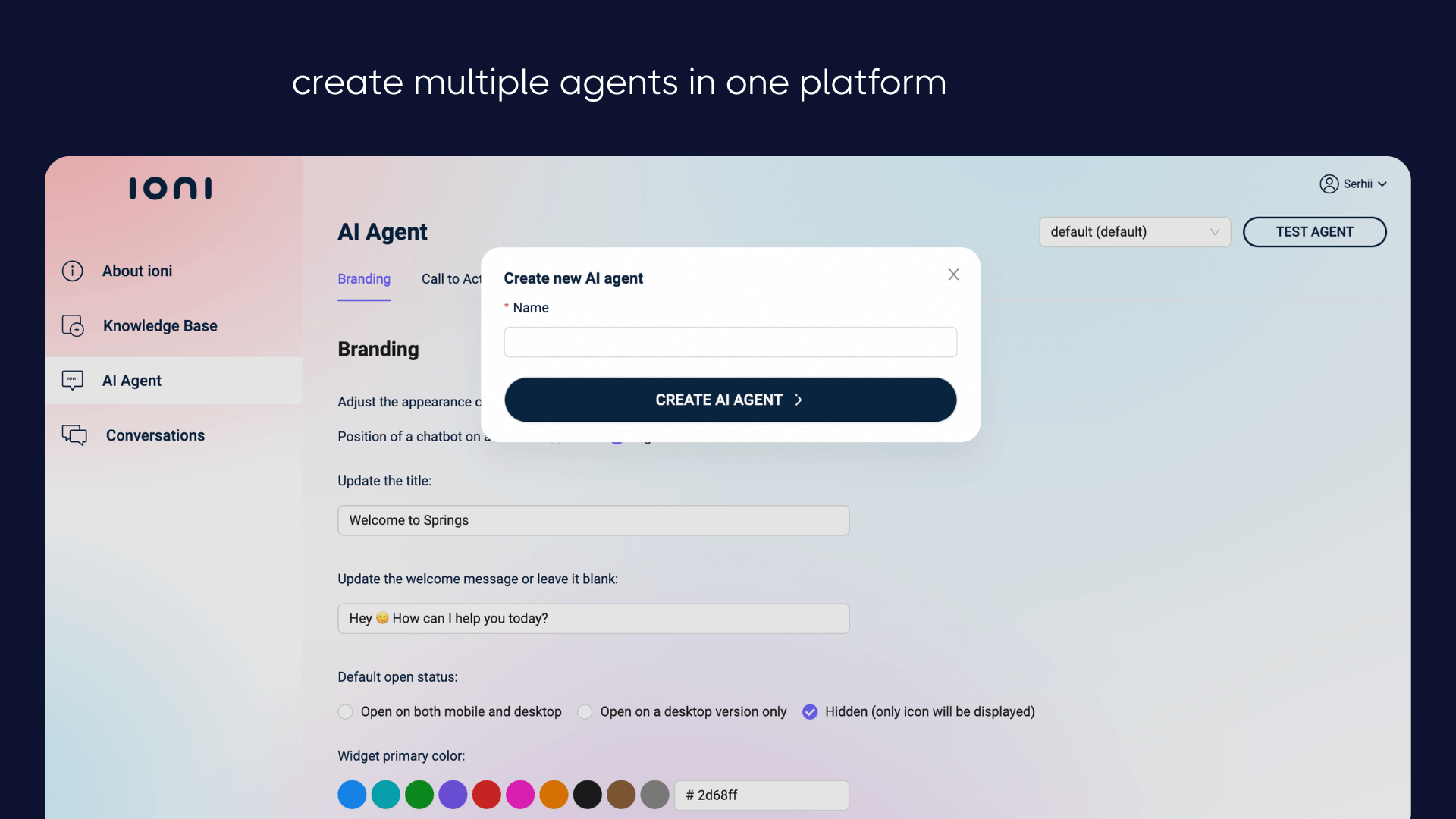
One of the biggest powers of IONI is the ability to be customized to your wishes and standards. Your solution may use an existing AI Agents platform, custom-coded elements, or integrate 3rd party tools. Our team connects all components and launches AI-enabled web and mobile apps. Helps you maintain and evolve a solution that actually works for your business.
Don’t hesitate to contact us so we can discuss your needs, problems, and opportunities. Our AI experts will recommend options, and possibly an MVP to act as proof of the concept. Once you are comfortable with the quality of AI Agents' work - we implement a full solution, add features, etc.
ELAI - Video Generation Agent
Another great example of intelligent agent is our product ELAI - an AI agent that allows you to create videos for learning or managing purposes with the integrated AI avatars (tutors).
At the core of Elai lies a revolutionary concept – simplifying the process of video content creation for various purposes, such as marketing, sales, HR, and education. Gone are the days when you needed costly equipment and specialized software to produce engaging videos.
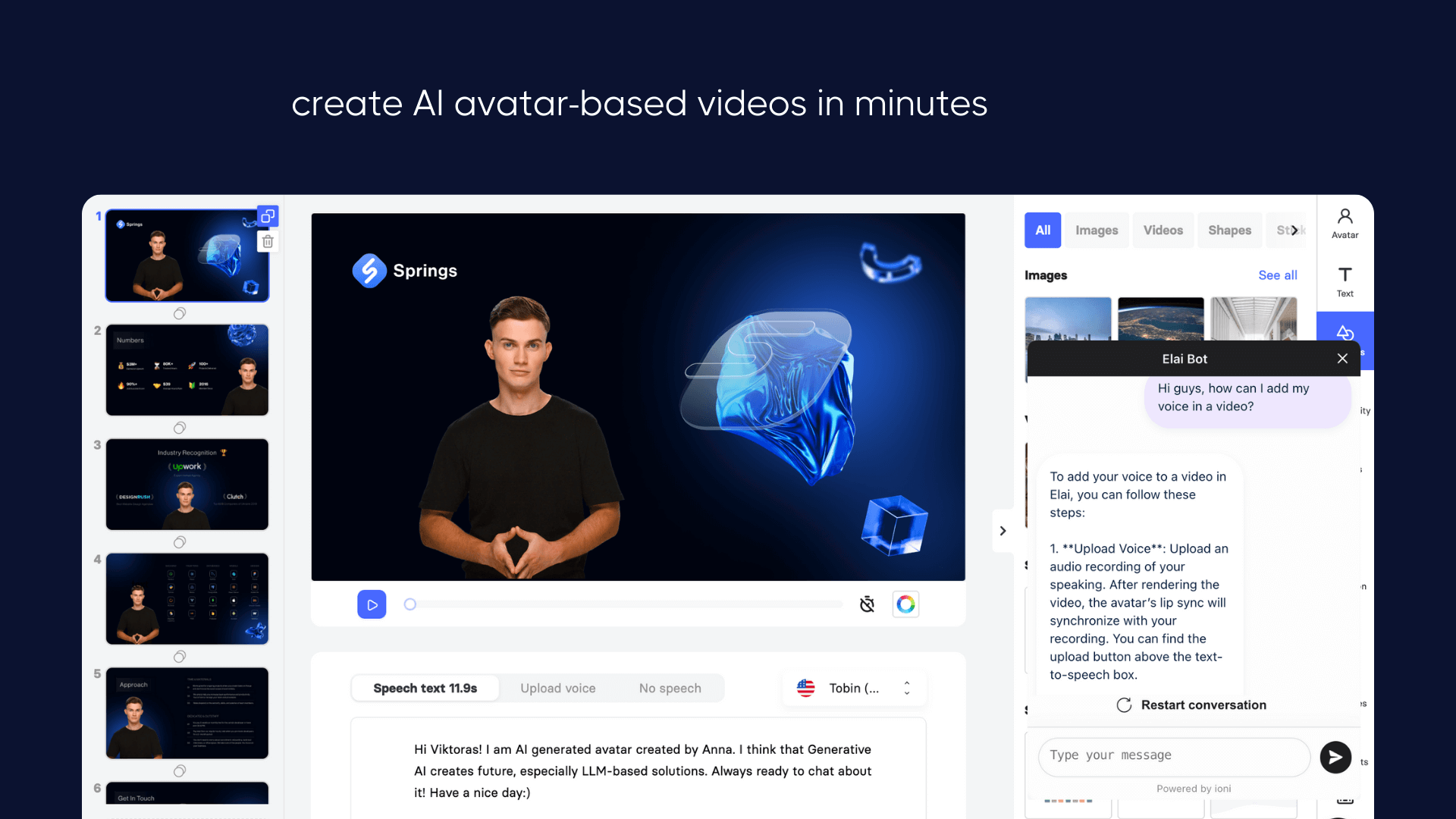
ELAI platform has redefined the landscape by empowering users to effortlessly transform text into dynamic video presentations, all guided by an AI-powered interactive presenter. This innovation opens up a world of possibilities, making video content creation accessible to individuals and organizations of all sizes.
Other Examples
Intelligent agents in artificial intelligence examples are transforming numerous industries by automating tasks and enhancing efficiency. For instance, AI-driven virtual assistants such as Apple's Siri or Amazon's Alexa use advanced natural language processing (NLP) to perform tasks, answer questions, and even control smart home devices, demonstrating the real applications of AI agents in everyday life.
In healthcare, intelligent agent in artificial intelligence examples include AI apps that assist doctors by diagnosing diseases, recommending treatments, and even monitoring patient vitals in real time. These agents use vast amounts of medical data to identify patterns and predict potential health issues before they become critical.
Another example of AI agents could be an autonomous vehicle, where intelligent agent processes data from multiple sensors to navigate roads safely, avoid obstacles, and make split-second decisions to ensure passenger safety.
Overall, integrating AI agents into various areas can increase business efficiency, reduce human error, and provide more personalized services.
The Future of AI Agents
This article I would like to finish with a great quote from Forbes: “AI agents are the source of tremendous hype today, which can make it hard to separate signal from noise in this space. But it is important not to lose sight of the big picture here: agentic capabilities will define the next great wave of progress in AI.”
A countless number of fields are filled by AI agents today: from custom web and mobile development to revenue operations, from patient care in healthcare to sales development representatives, and from product analytics to data engineering.
These areas represent just the beginning of what AI agents are currently capable of addressing. As the underlying technology continues to advance and improve, the range of tasks that can be delegated to these agents will expand rapidly within the next few years.
AI agents are not just another overhyped concept in the world of artificial intelligence. They represent the evolution of AI solutions. Very soon, interacting with various AI agents daily will become commonplace.

